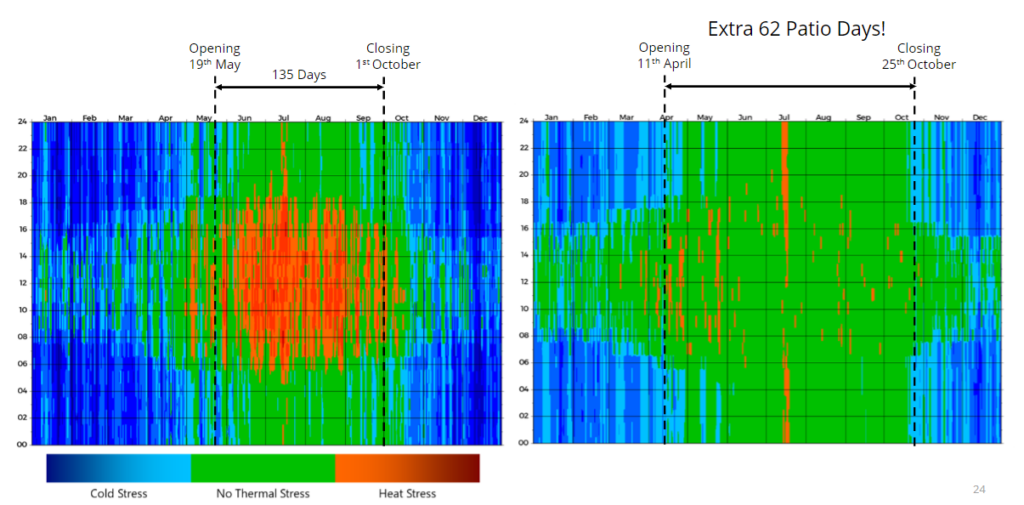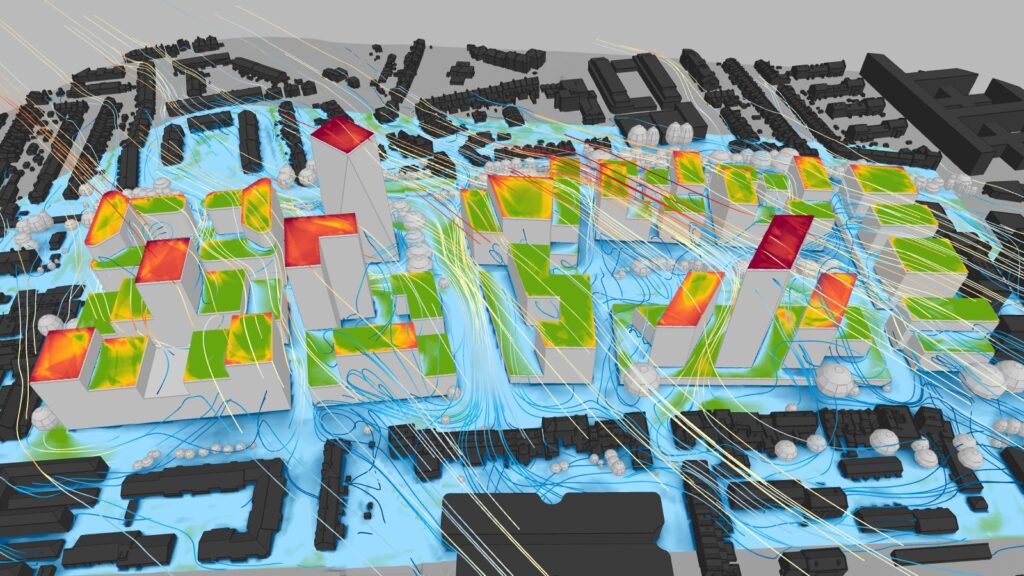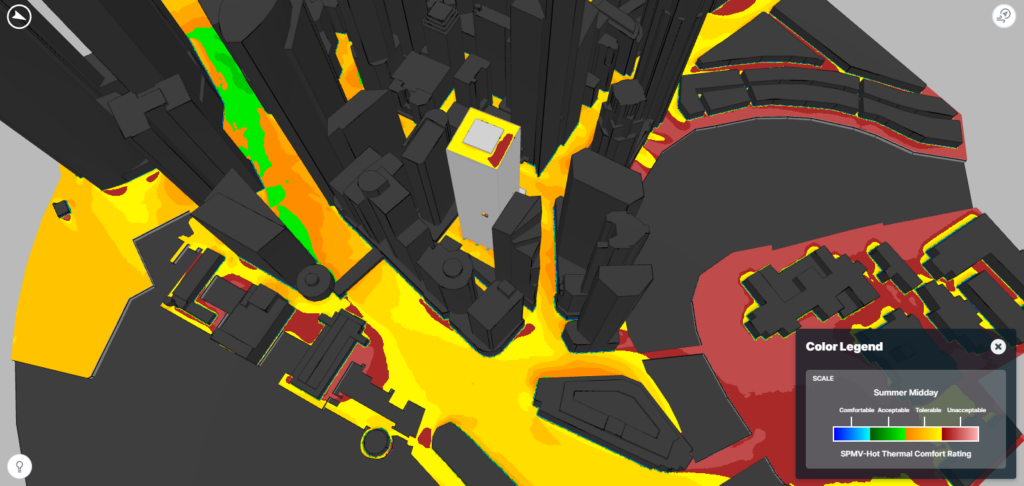Urbanization — the population shift from rural to urban areas — is one of the greatest forces reshaping our world. By 2050, it’s projected that 68% of the world’s population will live in urban areas (a huge jump from 54% in 2016), with developed countries seeing closer to 85%.
As urban population densities increase, so too does the importance of outdoor spaces: balconies, patios, gardens, parks, and so on. The value of these spaces, in economic terms and in social wellbeing, is directly linked to the number of days they can be used for their intended purposes.
Fortunately architects and designers have many tools at their disposal. One of the most powerful of those tools is microclimate simulation and climate analysis. In fact, by taking seasonal effects into account and engaging in conscientious microclimate engineering, architects can:
- maximize the comfort of outdoor spaces at crucial times of the day
- extend the number of days during which outdoor spaces are safely and comfortably usable by 30%.
Heat stress map

Heat stress map from a project in Toronto, Canada. Under the original design (left), users are subjected to extremes of hot (red) and cold (dark blue). These limit the hours in a day and the days in a year that outdoor spaces are fit for purpose. By incorporating mitigation strategies, the revised design (right) creates spaces that users can enjoy for many more hours on many more days
The impact of seasonal variations
In lower latitudes, there’s comparatively less change from season to season. The number of hours of daylight, the angle of the sun, prevailing wind patterns, and humidity levels all vary, but (generally) don’t do so enormously. As a result, architects have less difficulty ensuring the outdoor amenities in their building designs are comfortable for use throughout much of the year.
In contrast, locations at higher latitudes (generally) experience wider extremes. The sun might be directly overhead in the summer, while barely poking above the horizon in winter, and hours of daylight vary widely. Humidity can be oppressive in the summer, while winters and even shoulder seasons can be painfully dry. Lastly, summer months can experience long periods of stagnant air, while winter brings with it gale-force winds.
Climate change is making things tougher
In all latitudes, climate change is making things even more difficult by amplifying extremes. As a result, many regions are being forced to reckon with the impacts of climate change on long-term planning.
For example, a recent BBC article examining how Texas is racing to thwart the heat explores the “urban heat island” effect and explains that, “Austin, which is expecting a 50% increase of days above 38C (100F) by the end of the century — roughly 45 days of extreme heat every year — laid out a climate resilience action plan in 2018, which city officials are currently updating.”
Buildings are meant to last and planning for the future is a prudent strategy. It seems likely that more cities will be updating their municipal planning guidelines to account for this emerging reality.
Working with the climate to extend the seasonal availability of outdoor amenities
Located at nearly 54o latitude, Edmonton is North America’s northernmost city with a metropolitan population over one million. Despite the extreme seasonal variations that come with such a northerly location, Edmonton’s leaders are determined to make the city as livable and enjoyable as possible, for as much of the year as possible.
In pursuit of this goal, the city published comprehensive (and beautifully illustrated!) Winter Design Guidelines, to provide developers, architects, engineers, and planners with a framework for their projects.
The guide’s introduction, contributed by Norman Pressman — Founding President of the Winter Cities Association and Professor Emeritus, Urban Design & Planning University of Waterloo[LB1] — notes that, “We should not have to struggle against climate. Instead, we must form alliances with it,” before explaining that: “Edmonton possesses approximately 150 outdoor-comfort days (the number of days between 9oC in spring and 11oC in autumn), from early May to mid-October. But urban spaces designed to catch the sun, block the wind and reduce shadows from tall buildings can extend this time by up to 30%, meaning people can be outside in comfort up to four weeks earlier in spring and three to four weeks later in fall.”
Edmonton is a shining example of how cities can be made more livable and enjoyable throughout the year through conscious effort that manifests, at least in part, in how buildings are designed.
Climate analysis strategies
There are a number of climate analysis strategies available to architects who want to work with the climate to increase the availability of outdoor amenities. In practice, these strategies trade off impact and flexibility, and different ones are best applied at different stages of the design:
- Massing manipulation has a dramatic impact on a building’s microclimate, but is inflexible — so is best applied to early designs
- Canopies and landscaping have moderate impact and moderate flexibility and can help to further shape the microclimate when massing is established
- Active measures, like spilling air from the indoor environment to the outdoor environment, can be applied to fine-tune specific areas
In combination, these strategies can be employed effectively to create spaces that simultaneously achieve both wind comfort and thermal comfort.
Wind manipulation
Wind is a major determining climate factor in what activities are possible in an outdoor space. For example:
- Light breezes are desired for outdoor seating areas where patrons can read a paper without having it blown away à park benches, restaurant and café seating, balconies, amenity terraces, children’s areas
- Gentle breezes are suitable for passive pedestrian activities where a breeze may be tolerated à bus stops, dog areas, main entrances
- Relatively high speeds can be tolerated during intentional walking, running, and other active movements à sidewalks, parking lots, laneways
- Strong winds are considered a nuisance for most activities
There are many different ways that a designer can manipulate the flow of wind to create safe and comfortable spaces, including:
- Changing the number of buildings in a development plan
- Changing the orientation/location of buildings within a site
- Changing the setback of different parts of a building
- Reshaping the building
- Changing the height of a building
- Changing the offset distance of a tower from podium edges
- Including canopies and other small-scale architectural features
Solar manipulation
Sunlight also plays an important role in the comfort of outdoors spaces, both from direct exposure to patrons (including from reflections) and via radiation (i.e., heat) emitted from surfaces (shaded surfaces can be 11-24oC (20-45oF) cooler than unshaded areas).
And, as with wind manipulation, changing the orientation, shape, and massing of a building, and using features like canopies and overhangs, allows designers to consciously decide what role sunlight will play. For example, allowing morning and evening sunlight while blocking the baking midday rays can create a pleasant outdoor dining experience. This can tailor exposure to catch the lower angles from late spring and early fall can extend patio season without subjecting summer diners to extreme temperatures.
At the same time, providing patrons with options — including distinct areas within outdoor spaces and moveable elements like umbrellas — can improve the comfort of amenities while accommodating a diverse array of personal preferences.
Finding the right balance through climate analysis
Like many optimization exercises, creating valuable outdoor spaces comes down to striking a balance. Whether between multiple factors (e.g., wind and sun) or the needs of different seasons (e.g., working with summer winds to help achieve thermal comfort in summer, blocking the cold and drying winter winds).
And, again like many optimization exercises, deterministic conditions are in short supply, forcing architects to work with probabilities and distributions (e.g., localized historical trends of prevailing wind patterns).
Fortunately, climate analysis tools make it easy to explore the options and understand the trade-offs of different designs. Modeling, simulation, and analysis also help designers consider outdoor comfort factors holistically. For example, a sunshade may also provide mitigation of strong winds, and adjustable wind barriers can provide a cooling breeze on a hot day or be closed to stop gusts and prevent wind chill.
Climate analysis is important for any design that incorporates outdoor spaces, but is especially important for buildings in higher latitudes. It’s worth stressing the importance of localized input data. Locations at the same latitude (e.g., Edmonton, Hamburg, Dublin, Manchester) can have dramatically different climate patterns.
Analysis types to consider
To enable informed design decisions, Orbital Stack simulates wind conditions for the urban microclimate surrounding your building. It incorporates historical climate data for that location and illustrating the wind direction and strength at pedestrian height for every outdoor space designated in your CAD geometry.
With relevant factors — including time of day and season — set by the user, results provide an indication of the typical wind comfort conditions to expect around the site. The scales guide the designer to the appropriate uses of each outdoor space, allowing insight into causes and mitigation options where conditions aren’t appropriate.

Orbital Stack’s approach to daylighting analysis indicates where shadows would generally fall for given seasons and times of day, assuming the sky was clear every day. Plots are generated for each season and time-range indicating the solar potential (from 0% to 100%) for the given period.

Orbital Stack’s thermal comfort analysis combines wind and solar simulations of your site geometry with an array of climate data. This includes temperature, humidity, cloud cover, wind direction and speed, summarizing the results in plots that indicate the overall thermal comfort of patrons in that space.
By accounting for clothing and activity levels, users can divide the analysis into custom seasons and time ranges. This ensures that spaces achieve the design goals of the programming that was intended for them.

In summary, by using climate simulations and analysis to make informed decisions that carefully balance the effects of wind and the sun — specific to a particular location — building designers can maximize the economic value and social well-being of their outdoor spaces by ensuring these spaces are suitable for use for as many hours on as many days as possible.
